Coat of arms of Ukraine
| Coat of arms of Ukraine | |
|---|---|
 | |
| Details | |
| Armiger | Ukraine |
| Adopted | 19 February 1992 |
| Escutcheon | Azure, a tryzub Or |
| Earlier versions |
 |
| Use | Ukrainian People's Republic (1918-1920) |
The state coat of arms of Ukraine (Ukrainian: Державний Герб України Derzhavniy Herb Ukrayini), officially referred to as the Sign of Princely State of Volodymyr the Great[1] (Constitution of Ukraine, Article 20) or commonly the Tryzub (Ukrainian: Тризуб, "trident") is the national coat of arms of Ukraine, featuring the same colors found on the Ukrainian flag; a blue shield with a gold trident. It appears on the Presidential standard of Ukraine. Blue colored tridents are considered to be irregular representation by the Ukrainian Heraldry Society.
The small coat of arms was officially adopted on 19 February 1992, while constitutional provisions exist for establishing the great coat of arms, which is not yet officially adopted. The small coat of arms was designed by Andriy Grechylo, Olexiy Kokhan and Ivan Turetskyi. It is a representation of the seal-trident of Volodymyr the Great. The Great coat of arms which has not been adopted consists of the small coat of arms and the coat of arms of Zaporizhian Host (Constitution of Ukraine, Article 20).
The trident was not thought of as a national symbol until 1917, when one of the most prominent Ukrainian historians, Mykhailo Hrushevsky, proposed to adopt it as a national symbol (alongside other variants, including an arbalet, a bow or a Kozak carrying a musket, i.e. images that carried considerable historical and cultural and heraldic significance for Ukraine). On 22 March 1918, the Central Rada (parliament) adopted it as the coat of arms of the short-lived Ukrainian People's Republic.
During the Soviet period of 1919-1991 and independence between 1991-1992 the state symbols were consistent with the Russian SFSR and the Soviet Union - a hammer and sickle over the rising sun.
Tryzub
The modern "trident" symbol was adopted as the coat of arms of the Ukrainian People's Republic in February 1918. The design has precedents in seals of the Kiyivan Rus'. The first known archeological and historical evidence of this symbol can be found on the seals of the Rurik dynasty. It was stamped on the gold and silver coins issued by Prince Volodymyr the Great (980–1015), who might have inherited the symbol from his ancestors (such as Svyatoslav I Igorevich) as a dynastic coat of arms, and he passed it on to his sons, Svyatopolk I (1015–19) and Yaroslav the Wise (1019–54). The symbol was also found on the bricks of the Church of the Tithes in Kiyiv, the tiles of the Dormition Cathedral in Volodymyr-Volynskyi, and the stones of other churches, castles, and palaces. There are many examples of it used on ceramics, weapons, rings, medallions, seals, and manuscripts.
 From a coin of Volodymyr the Great (980–1015)
From a coin of Volodymyr the Great (980–1015) Seal of Sviatoslav I of Kiev (945)
Seal of Sviatoslav I of Kiev (945)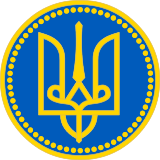 Seal of Volodymyr the Great (980)
Seal of Volodymyr the Great (980) Seal of Yaroslav the Wise (1019)
Seal of Yaroslav the Wise (1019) Ukrainian People's Republic (1918)
Ukrainian People's Republic (1918)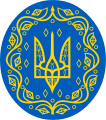 Ukrainian People's Republic, great arms, (1918)
Ukrainian People's Republic, great arms, (1918)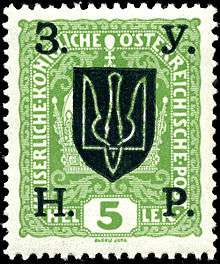
.svg.png)
Most historians agree that the medieval symbol was not intended as depicting a trident, but most likely a stylized falcon. Depictions of a flying falcon with a cross above its head have been found in Old Ladoga, the first seat of the Kievan Rurik dynasty,[2] of Scandinavian lineage.[3] Such a falcon, along with a cross are also featured on the coins of Olaf Guthfrithsson, a Viking king of Dublin and Northumbria.[2] Falconry for centuries has been a royal sport in Europe. The gyrfalcon (known also as Norwegian falcon) was considered a royal bird and is mentioned (ukr.: кречет) in one of the earliest epics of Ruthenia, the 12th century poem The Tale of Ihor's Campaign.
Later images of the trident ("tryzub") among the Rurikids resemble more a bident or the letter "У", which also in the modern Cyrillic alphabet denotes the sound "u" as in "Ukraine" (though the Cyrillic alphabet at the time did not have such a letter, using the digraph OѴ/Ѹ or its monogram Ꙋ instead).
Other uses
The Tryzub was also used in conjunction with the Russian tricolor, as the symbol of the anti-communist movement National Alliance of Russian Solidarists in the early 20th century. Furthermore, the Tryzub is heavily used in the military heraldry of the Italian Army to commemorate the Italian participation on the Eastern Front during World War II. At least 36 units of the Italian Army carry the Tryzub in their Coat of Arms, as they were awarded a Medal for Military Valor during their service on the territory of Ukraine.
Three-finger salute
A three-fingered hand salute is sometimes used to mimic the Tryzub;[4][5] as for example in pro-independence demonstrations in the late 1980s and in the logo of the (Ukrainian) Svoboda party.[5]
Historical coats of arms
Kingdom of Rus
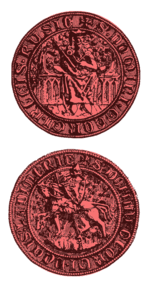
The coat of arms for Kingdom of Rus (Latin: Regnum Russiæ) and Duchy of Galicia–Volhynia existed since 12th century. It consisted of lion rampant Or on heater shield Azure. After the occupation of Eastern Galicia by the Kingdom of Poland as a result of the Galicia–Volhynia Wars, the coat of arms with many changes was adopted as part of the Ruthenian Voivodeship (Latin: Palatinatus russiae, Russian Palatine). It was abandoned with partition of Poland and annexation of territory by the Austrian Empire. At the end of World War I and dissolution of Austria-Hungary, the West Ukrainian People's Republic revived the coat of arms. With annexation of the West Ukraine by Poland again in 1918 and later the Soviet Union, the gold lion symbol became coat of arms for city of Lviv.
| Kingdom of Rus (West Ukraine) | |||
|---|---|---|---|
 |
 |
 | |
| Coat of arms of the Kingdom of Rus | Coat of arms of the Ruthenian Voivodeship | Coat of arms of the West Ukrainian People's Republic | |
Kozak with musket
A Cossack with a musket was an emblem of the Zaporizhian Host and later the state emblem of the Hetmanate and the Ukrainian State. The origin of the emblem is uncertain, while its first records date back to 1592. On the initiative of Pyotr Rumyantsev the emblem was phased out and replaced by the Russian double-headed eagle in 1767.
A Cossack with a rifle was restored by the Hetman of Ukraine Pavlo Skoropadsky in 1918. However, later the emblem disappeared again until in 2005 it reappeared on the proposed Great Seal of Ukraine.
| The Zaporizhian Host (Ukrainian State) | |||
|---|---|---|---|
.svg.png) |
 | ||
| Coat of arms of Zaporizhian Host | Coat of arms of the Ukrainian State (1918) | ||
Carpathian Ruthenia
The coat of arms was created after the end of the First World War, when Carpathian Ruthenia (then called Subcarpathian Rus') was transferred from Hungary to the newly created state of Czechoslovakia. It was designed in 1920 by Czech historian Gustav Friedrich. The Ruthenians had been promised autonomy within the new country, and therefore a coat of arms was created for their land.
| Carpathian Ruthenia | |||
|---|---|---|---|
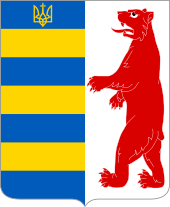 |
 | ||
| Coat of arms of Carpathian Ruthenia | Coat of arms of the current Zakarpattia Oblast | ||
The coat of arms shows the Ukrainian tinctures (heraldic colours) of blue and gold in its first (dexter) field and a red bear on silver in its second field. The bear is perhaps a symbol of Carpathian wildlife. The horizontal lines (in heraldry called bars) could perhaps have been inspired by the partitions per fess in the coat of arms of Hungary, to which the territory had belonged.
The arms were also used by the short-lived state of Carpatho-Ukraine in 1939, but with the addition of the Ukrainian trident in the uppermost blue field, used previously by the Ukrainian People's Republic. Since the territory is the same for the current Zakarpattia Oblast, the oblast uses the arms as its own.
Ukrainian Soviet Socialistic Republic
The coat of arms of the Ukrainian Soviet Socialist Republic was adopted on March 14, 1919 by the government of the Ukrainian Soviet Socialist Republic and subsequently modified on November 7, 1928, January 30, 1937 and November 21, 1949. The coat of arms of 1949 is based on the coat of arms of the Soviet Union and features the hammer and sickle, the red star, a sunrise and ears of wheat on its outer rims. The rising sun stands for the future of the Soviet Ukrainian nation, the star as well as the hammer and sickle for the victory of communism and the "world-wide socialist community of states". The banner bears the Soviet Union state motto ("Workers of the world, unite!") in both the Ukrainian and Russian languages. The name of the Ukrainian SSR is shown only in Ukrainian.
After independence on August 24, 1991, Ukraine retained the Soviet emblem. The next year, in 1992, the emblem was changed to the present coat of arms of Ukraine, the tryzub (trident) coat of arms.
| Emblem of the Ukrainian Soviet Socialistic Republic | |||
|---|---|---|---|
.png) |
_(black_version).jpg) |
.png) |
 |
| 1919-29 | 1929-37 | 1937-49 | 1949-92 |
Other variations
 Sich Riflemen emblem on the cockade
Sich Riflemen emblem on the cockade OUN-M 1929— 2010
OUN-M 1929— 2010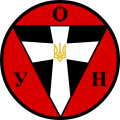 OUN-B 1940— 1958
OUN-B 1940— 1958
 City of Lviv in the Soviet Union (1967-1990)
City of Lviv in the Soviet Union (1967-1990) Variation of Pogon Ruska for the city of Kamianets-Podilskyi in (1374-1796) until occupation of Podolia by Russian Empire
Variation of Pogon Ruska for the city of Kamianets-Podilskyi in (1374-1796) until occupation of Podolia by Russian Empire Variation of Pogon Ruska for the city of Nizhyn
Variation of Pogon Ruska for the city of Nizhyn January Uprising's coat of arms of a proposed Polish–Lithuanian–Ruthenian Commonwealth
January Uprising's coat of arms of a proposed Polish–Lithuanian–Ruthenian Commonwealth
Great coat of arms
 Bytynsʹkyĭ proposition
Bytynsʹkyĭ proposition Bytynsʹkyĭ proposition
Bytynsʹkyĭ proposition Bytynsʹkyĭ proposition
Bytynsʹkyĭ proposition Hrushevsky's proposition
Hrushevsky's proposition 1996 proposition (without color)
1996 proposition (without color).png) 1996 proposition (with color)
1996 proposition (with color)
Constitutional provisions exist for the establishment of a Great Coat of Arms of Ukraine,[6] although it was never officially adopted and was published in various heraldic sources. In this variant, the shield is supported by a lion from the Galician Coat of Arms on the left and a Kozak in traditional dress, wielding a musket, the symbol of the Kozak Hetmanate on the right. The Coat of Arms is crowned with the crown of Volodymyr the Great, symbolizing Ukrainian sovereignty and decorated with viburnum and wheat at the bottom.
The official adoption of the Great Coat of Arms has to be endorsed by a majority of a two-thirds vote in the Verkhovna Rada, the Ukrainian parliament.
In 1917 Mykhailo Hrushevsky proposed the Great Coat of Arms in the form of a single shield topped by a dove with olive branch. The shield was split five ways. At its center there was a smaller shield depicting a plough as a symbol of productive peaceful work surrounded by state symbols of the old Ukraine: the princely arms of Volodymyr the Great (tryzub), Litvin Pogon with a golden lion, kozak with musket, the crossbow of Kiev and the lion of Lviv.
See also
- Symbols of the Rurikids
- Columns of Gediminas
- Emblem of the Ukrainian Soviet Socialist Republic
- Coats of arms of the regions of Ukraine
References
| Wikimedia Commons has media related to Coats of arms of Ukraine. |
- ↑ About symbols of the Ministry of Information Policy of Ukraine. Presidential ukase. 25 December 2015
- 1 2 Coat of arms of Rurik found in Ladoga. (Russian)
- ↑ Rurik (Norse leader) Britannica Online Encyclopedia
- ↑ Orange Revolution serves as a model for public school students in the South Bronx, The Ukrainian Weekly (4 September 2005)
- 1 2 Svoboda party – the new phenomenon on the Ukrainian right-wing scene Archived April 1, 2012, at the Wayback Machine. by Tadeusz Olszański, Centre for Eastern Studies (July 5, 2011)
- ↑ Constitution of Ukraine, Article 20.
- Pritsak, Omeljan (1998). The Origins of the Old Rus' Weights and Monetary Systems. Cambridge, Massachusetts: Harvard Ukrainian Research Institute. ISBN 0-916458-48-2.
- Zhukovsky, Arkadii (1993). "Trident (tryzub)". Encyclopedia of Ukraine. vol. 5. Retrieved 2009-03-26.
